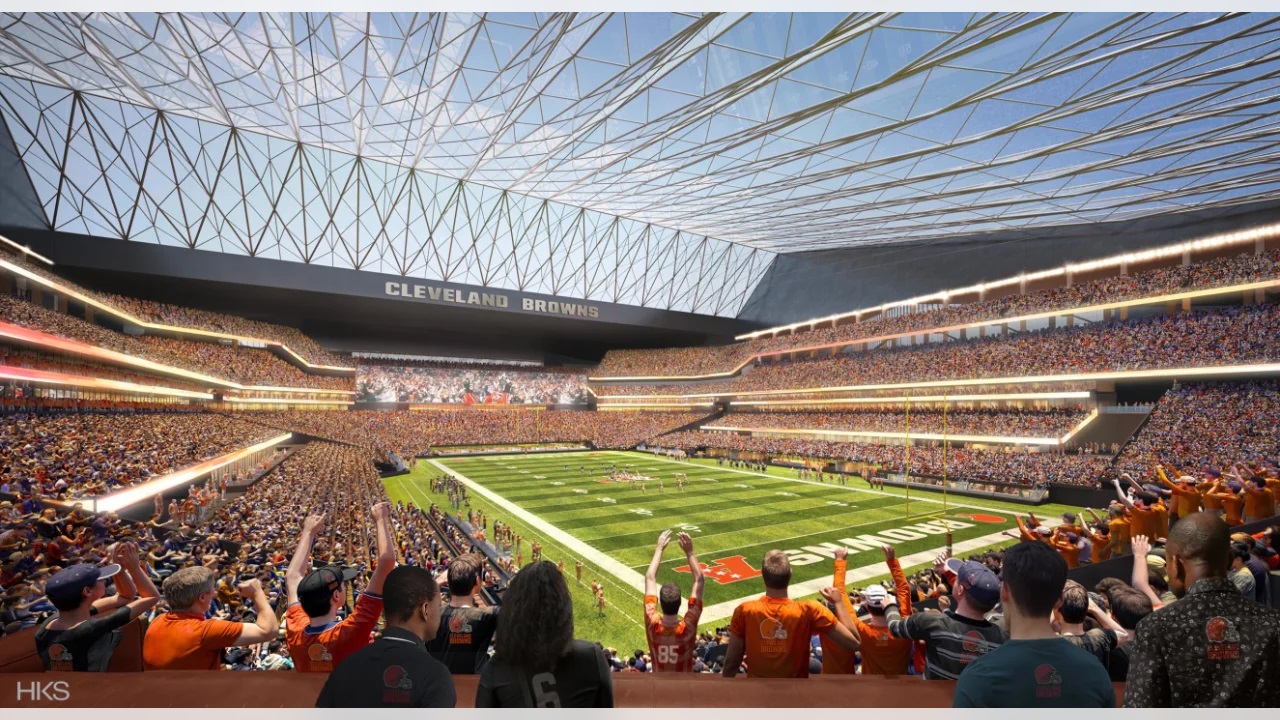The Haslams' have retained the same architecture firm that designed NFL palaces SoFi Stadium, U.S. Bank Stadium and Lucas Oil Stadium. (Cleveland Browns)
You must have an active subscription to read this story.
Click Here to subscribe Now!
Editor's note: Tony Grossi is a Cleveland Browns analyst for TheLandOnDemand.com and 850 ESPN Cleveland. He has covered the Browns since 1984.
There are many phases to complete for the Haslams and area politicians to agree on the future home of the Cleveland Browns.
Consider this the public relations phase.
Cleveland Mayor Justin Bibb actually jumped the gun on August 1 when he released details of the city’s proposal to keep the Browns on the lakefront in a $1 billion-plus, refurbished, open-air stadium.
The Browns’ owners were with their team at The Greenbrier Resort when they received short notice that the mayor was going public with details previously considered by the parties to be confidential.
The notice included a tart jab below the belt – a deadline of August 12 to respond to the city’s offer of $461 pledge in future user tax revenues.
Or else what? Left unsaid.
So the Browns responded on Wednesday with their own PR punch. And it was quite a haymaker.
In a letter to season-ticket holders and media, which took social media by storm, the Browns unveiled the worst-kept secret in this stadium debate. They want to build a “transformational” state-of-the-art, covered stadium in Brook Park surrounded by a lifestyle and entertainment district featuring restaurants, hotels and upscale residences.
The project “would catalyze our region in a major way” … “drawing visitors throughout the year and driving substantial fiscal impact for our region.”
The letter contended the Haslam Sports Group is “currently evaluating” the city’s proposal to keep the Browns on the lakefront. But it left no doubt the Haslams are proceeding on a fast track to Brook Park to build a $2.4 billion palace surrounded by up to 15,000 parking spaces with public funding help. The commercial district, estimated to cost over $1 billion, would be privately financed.
“While significant work remains, the more we have explored the Brook Park option, the more attractive it has become, and we are excited to share the current vision with you,” Dave Jenkins, COO of the Haslam Sports Group, wrote in the letter.
The multi-media package includes renderings of the modernistic, glass-walled indoor stadium that juts subtly above ground, topping off comfortably under the landing pattern of flights descending on nearby Cleveland-Hopkins International Airport. The field would be 80 feet below ground level.

The stadium would be designed by Dallas-based international architect HKS, Inc., which counts SoFi Stadium in Ingelwood, CA, U.S. Bank Stadium in Minneapolis, MN, and Lucas Oil Stadium in Indianapolis in its NFL portfolio.
The artfully conceived PR package includes a 3-minute video that tours the proposed project from all angles outside and inside and includes snippets of other events besides football hosted in the stadium.
The prevailing message of the slickly-produced presentation is to explain the benefits to the Northeast Ohio region of not just a domed stadium in Brook Park but also a developed lakefront without a Browns stadium.
“Developing the lakefront without the stadium could be the best way to maximize the long-term success of our underutilized North Coast waterfront asset,” Jenkins wrote. “We continue to have dialogue with the City regarding the optimal use of the lakefront, and will remain engaged on this critical priority regardless of where the stadium is. We will also keep working with our public partners in earnest so that the stadium solution is a long-term win for everyone, including the City of Cleveland.”
Jenkins disclosed why they chose the Brook Park site.
“We have considered not only the Brook Park site but also other locations for a future dome stadium, including Burke Lakefront airport, which we have determined with the City of Cleveland is not feasible,” Jenkins wrote. “We also cannot put a dome on the current building because of economic constraints and FAA restrictions.
“The Brook Park site is the most compelling option for a dome for several reasons: its central location for our regional fan base, its proximity to downtown, the RTA and the airport, and its strong existing infrastructure. The large footprint is also ripe for major economic development and supports ample parking and optimized ingress/egress for our visitors. Our diligence of the site is ongoing, but our work to date has shown positive results on the FAA, environmental and traffic/infrastructure fronts.”
Jenkins says the Haslams seek a 50-50 public-private partnership in financing the stadium project “as demonstrated in other markets,” and says HSG would cover any cost overruns.
“Importantly, we are not looking to tap into existing taxpayer-funded streams, which could divert resources from other pressing needs,” Jenkins wrote. “We are instead working on innovative funding mechanisms with local, county, and state officials that would leverage the fiscal impact of the project and the unprecedented private contribution to support the public investment and generate a substantial return for Brook Park, Cuyahoga County, and the State of Ohio.
“While still in progress, our funding model also contemplates setting aside future dollars generated by the project for stadium repairs and maintenance to help ensure long-term sustainability of the building well beyond the initial lease term.”
It’s a breath-taking presentation, a game-changer in the stadium conversation. Now the Haslams have to convince the powers-that-be that building in Brook Park would be a game-changer in the future of Northeast Ohio, as well.